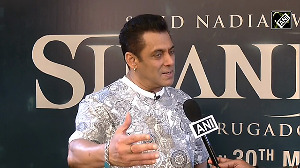'The more educated a young person is, the higher the chances of him or her remaining unemployed.'

In March 2024, the International Labour Organization (ILO) and the Institute of Human Development (IHD) jointly published the India Employment Report 2024.
The highlight of which was the unemployment crisis the country experienced.
The report stated that 83% of India's unemployed workforce are young people, and the unemployment rate for young people with secondary or higher education is six times higher than the rate for those who can't read or write
It said, 'A large proportion of the population is of working age, and India is expected to be in the potential demographic dividend zone for at least another decade. But the country is at an inflexion point because the youth population, at 27 per cent of the total population in 2021, is expected to decline to 23 per cent by 2036. Each year, around 7-8 million persons are added to the labour force whose productive utilization could lead to India reaping a demographic dividend.'
Though unemployment is the biggest worry for young India, sadly, it was not a priority for the politicians during the elections.
"Has any politician spoken about the high unemployment the country is facing, or lack of employment opportunities? Was it a topic of discussion during the elections? Has any politician made any suggestion on how India should move forward?", Professor Kodoth Prabhakaran Nair, former National Chair of the Science Foundation, The Royal Society, Belgium and a Senior Fellow of the Alexander von Humboldt Research Foundation of The Federal Republic of Germany, asks Rediff.com's Shobha Warrier.
You wrote recently that India was in the demographic dividend zone where the working age population exceeded that of the very young and the old.
What happens when a country is in that zone?
If you take India's demographic dividend, it has an age group which can work. And this demographic dividend will be there for another decade and a half, at the most.
But the tragedy of this is that they are not in any meaningful employment.
If you take a state like Kerala for example, because the employment opportunities are very less here, this demographic divided migrate from here.
What will happen when you treat only the symptoms and not the cause of the disease you suffer from?
Now, why I gave the analogy of disease is because the cause for the disease here is the educational system that is followed in India.
Unfortunately, our educational system does not meet the needs of the emerging society. Here, irrespective of what the child's aspirations or capabilities are, he or she is forced to learn many things. A child's real capabilities are not tapped or explored.
When nothing is forced upon a child of 5 in Germany, here a child of 5 carries a big bag full of books to school.

You mean the disease you spoke about is India's education system?
Exactly. It is like a doctor treating the symptom without looking into what caused the disease when a person is sick.
Having worked all over the world, I feel pushing a child into the system at the primary level itself, is harming the child.
I will give you another example from my experience. When I was heading the National Chair of Science Education in Belgium, I had to guide research students too, and I had students from all over the world. One of them was an Assistant Professor from India.
There I was discussing a science problem with a European doctor student on what had to be done, and after that he was on their own.
On the other hand, the assistant professor from India had to be spoon-fed at every step.
Why is it so? The rot starts at the primary school level itself.
The problem with India is, we have a vast number of the so-called educated people in India. Unfortunately, they are not employable.

Industry in India has been complaining for a long time that engineering graduates in India, for example, are unemployable...
Yes, they may be educated but they are not employable.
It clearly shows education does not make a person eligible for a job.
And unemployment is higher among the educated youth, who account for 66% of the country's unemployed people.
The more educated a young person is, the higher the chances of him or her remaining unemployed.
As per a study, 29% of the educated youth are unemployed.

Then, what is the demographic dividend or advantage we are talking about?
Take Kerala for example. Notwithstanding what (Kerala Chief Minister) Pinarayi Vijayan is saying, a huge percentage of the young population from Kerala is migrating to other states. That's because there are no jobs here.
Now, it is not the case of Kerala alone. According to the World Bank's latest report Jobs for Resilience, South Asia has the highest outflow of migrants among the emerging markets and developing economies. It includes India too.
And because of lack of job opportunities, Indians are migrating to other countries.
And 90% of the global youth population reside in the developing and poor countries, including India.
It is because these countries cannot generate enough employment opportunities to meet the growing aspirations of the youth that they are migrating.
Because these countries are not creating employment, they will not be able to take advantage of the demographic divided they have.
Has any politician spoken about the high unemployment the country is facing, or lack of employment opportunities? Was it a topic of discussion during the elections? Has any politician made any suggestion on how India should move forward? No.
90% of the newspapers write about what every politician said. Did we see a single concrete idea written about in any of the papers?
Unless radical changes are made right from the primary education level, you are not going to solve the problem.

When most of the developed countries are aging, we have a huge young population, but we are not able to give them employment and take advantage of the situation.
What will this lead to?
They will migrate where they are needed. Kerala is a classic example of the migration of the working age population.
If you take countries on the European continent, a very large number of migrants are working there. That's because these countries are aging and there are no young people to do the jobs.
These young migrants are replacing a working population which is above 70 and are not able to work. They live long but are not able to contribute anything to the economy.
The migrants fill the gap so that the system works there.
So, if India which has this demographic dividend advantage right now, needs to take advantage of the situation, the planners sitting in Delhi or any other place who are writing the destiny of this nation, has to start changing things at the base level, at the educational level.

Now, only 6.1% of India's population is above the age of 65. Once India starts aging...?
As of now, we have the advantage of the population demographic dividend but it will not last forever.
The 2018-2019 Economic Survey says that the demographic dividend would peak around 2041, when the working age group will be 59% of India's total population.
You have to also realise that India will have this advantage for a decade-and-a-half, at the most. This won't last forever.
According to ILO, the youth population of India will dip from 27% in 2021to 23% by 2036.
You have to also remember Indian youth account for nearly 83% of the total country's unemployed population.
And every third young Indian is unemployed.
Feature Presentation: Aslam Hunani/Rediff.com










 © 2025
© 2025